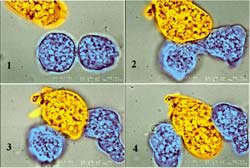|
|
DISCOVER Vol. 23 No. 1
(January 2002)
Researchers have long observed that Amoebas reproduce through fission, but
until this year no one realized the process always stalls, with the two
daughter cells apparently frozen together. In March, researchers at the
Weizmann Institute of Science in Rehovot, Israel, announced that not only do
cells stall in mid-delivery, but they also get help. Other amoebas often make
a beeline to the distressed daughters to nudge the two cells apart. "For
an amoeba, which doesn't usually display much sense of direction, it was an
unexpected behavioral observation, to say the least," says Elisha Moses,
a biophysicist who led the research. Rather than being an isolated case of altruism, this amoebic midwifery
turns out to be routine. The distressed cells release a chemical attractant,
says Moses, which signals nearby members of the species to come to the
rescue. Understanding this fission phenomenon may give researchers an idea of
how to deter it. "If there's a way to interfere with this process, then
there may be a way to limit their growth rate," says Moses—as well as
prevent a lot of human misery. These amoebas cause human dysentery and death
among AIDS patients, particularly in the third world. "You have to look at a slow sequence of events for a long time before
you realize what you're seeing," says Moses. But such patience is rare
these days. "Everybody has moved on to genetics, which involves slicing
and dicing organisms," he says. "Simply watching them under the
microscope is out of fashion."
|
